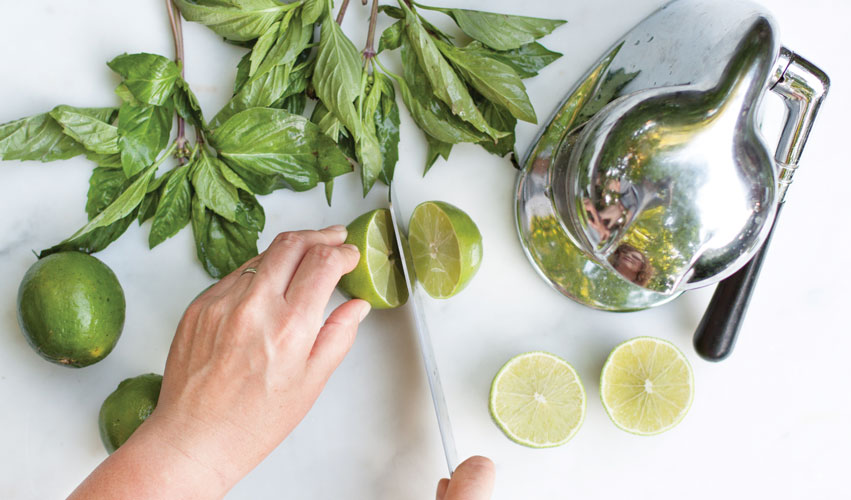Today’s culinary world leaves convenience foods behind in favor of fresh, locally-sourced ingredients.
Aquafaba… If you haven’t heard of it, you may be surprised by its description: the viscous water in which beans and legumes, like chickpeas, have been cooked (thus aqua, Latin for “water,” and faba, Latin for “bean”). Perhaps more surprisingly, it’s one of the latest food trends taking America’s kitchens by storm. When whipped, the liquid takes on a quality much like egg whites—making it the perfect substitute for everything from colorful meringues to dairy-free mayonnaise.
And that’s just one trend in the culinary world of 2017. The National Restaurant Association’s latest survey of professional chefs highlights everything from heirloom vegetables, new cuts of meat and street-food inspired dishes, to hyper-local food sourcing and a “back-to-basics” return to simple meals.
According to Chef Golda Ewalt, these trends are easy to try out in Peoria. Ewalt is a registered dietitian, catering manager at OSF Saint Francis Medical Center and director of the OSF Dietetic Internship Program. A Certified Chef de Cuisine through the American Culinary Federation, she is also the current president of the Heart of Illinois Professional Chefs Association. For her, these trends reflect a growing desire to leave “convenience foods” behind in favor of fresh, locally-sourced ingredients.
“Celebrate what’s in season,” Ewalt declares. “You can’t beat the flavor… and you need minimal preparation.”
 The Next Frontier
The Next Frontier
Though cauliflower was once little more than an afterthought, the humble vegetable has more recently taken center stage at restaurants around the world. “The joke is that cauliflower is the new kale,” Ewalt notes. Much like tofu, cauliflower is known for its ability to take on other flavors, and it is a suitable substitute for meat in vegetarian dishes.
Here in Peoria, the restaurant Thyme has utilized cauliflower in this way, offering a vegetarian tenderloin with Panko-breaded cauliflower. A quick glance at online recipe forums reveals a range of related ideas: General Tso’s cauliflower, buffalo cauliflower, even cauliflower rice—in which cauliflower florets are transformed into a healthy, low-carb rice substitute after just 60 seconds in a food processor.
Heirloom fruits, vegetables and grains are also immensely popular at the moment—a trend that Ewalt applauds. While heirloom tomatoes have been available at local farmer’s markets and specialty stores for several years, she suggests that consumers seek out other kinds of heirloom products as well, such as beans and legumes. Seed Savers Exchange, an Iowa-based company, is a wonderful source for culinary varieties.
“We bought Christmas Lima beans, and when you cooked them, they were larger than a quarter… with an absolutely beautiful burgundy color,” Ewalt describes. “They were delicious in every way!” Plus, she adds, beans are healthy, filling, inexpensive and versatile. “I really encourage us to eat more beans. You can have them hot, cold, in a soup or make a dip.”
While ancient grains are becoming increasingly popular, they have yet to take off in Peoria—but Ewalt expects this trend to hit our area soon. Taste is one of the driving factors, since consuming heirloom varieties is an experience far removed from what can be found in most grocery aisles. Locally, chefs like Dustin Allen of Edge and Ryan Smith at Midnight Espresso have begun to incorporate locally grown heirloom grains into their menus.
“Some of the grain they use comes from Spence Farm in Fairbury, Illinois,” Ewalt notes. “They have an annual camp where they bring in chefs to teach them how to use these locally grown grains. I think it’s going to be the next frontier.”

Keep It Simple
When it comes to preparation and technique, chefs are trimming down their ingredient lists and letting the food speak for itself. “What’s hot right now is simplicity,” Ewalt suggests. “Celebrating—instead of trying to cover up—the wonderful flavors of what is in season.”
One of her favorite recipes, “Just Tomatoes,” is a soup that pays tribute to the taste of freshly cut summer tomatoes. Aside from a bit of salt, pepper and lemon juice, the recipe is true to its name. “You are totally enjoying that perfect tomato in summer,” she explains. “It’s simplicity at its finest.” It’s visually appealing as well, and the taste is surprisingly complex—especially when consumed through a flavorful “straw,” such as a hollow stem of lovage.
In keeping with the idea of simplicity, Ewalt says that grilling vegetables continues to grow in popularity. She enjoys using her cast-iron cookware on the grill, adding that it’s hard to beat the smoky taste of a good fire. “I’ll put a cast-iron pan on my grill, let it get hot, throw a little oil in there, and toss the vegetables. It’s absolutely perfect… especially for potatoes.” It also means you won’t heat up your kitchen in the summer with a hot oven—a definite bonus. Outside of summertime, though, oven roasts are hard to beat. “Roasting vegetables really brings out their sweetness,” she explains.
Ewalt notes that simplicity doesn’t mean eschewing additional flavors; it just means using fresher ingredients. She enjoys using various vinaigrettes once the vegetables are cooked, and sticking to fresh herbs over dried whenever possible. “Try different oils,” she recommends. “Olive oil is great—but some really nice, very flavorful oils include walnut oil, almond oil, pumpkin seed oil and pistachio oil.” Because they are used for dressing vegetables and salads—and not cooking them—a little bit of these finishing oils goes a long way.
For creamier sauces, Ewalt suggests keeping it simple by pairing yogurt, minced garlic and freshly chopped herbs with salt and pepper to accompany roasted vegetables. She also makes an all-purpose herb seasoning, kept sealed in an airtight container in her refrigerator. “Put salt, black pepper, garlic, sage, rosemary and red pepper flakes in a food processor—a wet seasoning that goes on anything and is absolutely delicious!”
Fermented foods are also going mainstream—with images of homemade pickles, sauerkraut and kimchi trending on social media sites like Instagram, where their health benefits are lauded. “And then you get into homemade yogurt, kefir and kombucha,” says Ewalt. “As a dietician and a chef, I like that they are all very healthful foods. Most of them contain probiotics—and there is a lot of research and studying of the benefits right now.”
Meanwhile, if you’re crunched for time, Ewalt proposes another trend: pressure cooking. “What’s old is new again,” she explains. “A lot of the older techniques are coming back. Pressure cookers are great for soups, grains and meat. It’s a great way to take a cheaper, tougher cut of meat and make it delicious and succulent.” She also recommends pressure cooking as a way to quickly cook dry beans and avoid the overnight soak—in about 30 minutes, a bag of dry beans can be ready to use in recipes.

Local… and Hyper-Local
In Yountville, California, Chef Thomas Keller’s acclaimed restaurant, The French Laundry, has its own culinary garden right across the street, which supplies a large part of its produce. The menu changes daily based on what’s available in the garden, ensuring that customers eat food when it is at its finest. This particular trend, known as “hyper-local sourcing,” has become quite popular in recent years—and it can be found here in Peoria at restaurants like Childers Eatery.
“They have a garden behind their restaurant on University Street,” Ewalt explains. “They’re literally walking out the back door… and grabbing food to use to feed their customers.”
If you aren’t quite ready to tend your own garden at home, Ewalt suggests joining a CSA (community-supported agriculture), which connects farmers directly with consumers through a subscription model. “You pay up front,” she notes, “but for us, starting in April through October, we get produce for around $20 a week. You make a commitment to eat more meals at home—and when you eat at home, you’re typically going to save money.” You’re also supporting local farmers—which means accepting that some years might bring more produce than others. “When the farmer has a good season, you reap the benefits of that. If there’s a drought or too much rain, you are also sharing in the cost.
“You have to be willing to be creative and utilize what comes in your CSA box,” she adds. “I think it’s a great way to save money, support local agriculture and eat healthy.”
But if a CSA is too much of a commitment, Ewalt says consumers can still save money (and support local farmers) by visiting local farmer’s markets. “We have done a price comparison of local, seasonal produce alongside grocery store prices. We found them to be extremely comparable across the board—with the exception of local organic eggs, which were more expensive than the grocery store.”
 Taste, Not Waste
Taste, Not Waste
By eating locally sourced food, one tends to experience an increased environmental awareness, which is also helping to push the trend. “People understand how small, local farmers respect the land and take care of it,” Ewalt explains. “For example, if we get an avocado from Mexico and it goes bad before we can eat it, we’re not only throwing away the avocado, but the resources used to produce it: the water, the fertilizer and the transportation resources used to ship it to you.”
Food waste is a problem that is only increasing, and Ewalt says it’s a huge topic among area chefs. Earlier this year, Chef Dustin Allen hosted a special dinner at Edge that focused on food waste reduction. “That’s cutting-edge,” Ewalt says. “He maximized the use of the plants and animals. In the future, we may be taxed or charged by how much food waste we throw into landfills. There are cities around the country that are now providing bins for food waste curbside recycling—they take the food waste for composting and put it back into the soil.”
While there is no shortage of benefits to eating locally, at the end of the day, it’s all about one thing. “Taste is always the driver. It’s taste, taste, taste,” Ewalt declares. “Food has to taste good.” And that is a promise current food trends do not fail to deliver. a&s


